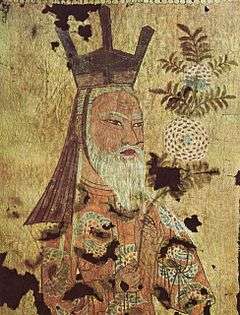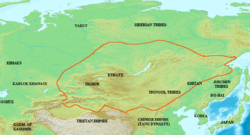Bayanchur Khan
| Bayanchur Khan | |||||
|---|---|---|---|---|---|
|
Khagan | |||||
| Reign | Uyghur Khaganate: 747–759 | ||||
| Predecessor | Guli Peilo | ||||
| Successor |
Bogu Khagan ( 759-779 ) Qutlug tarqan sengün | ||||
| Born | 713 CE[3] | ||||
| Died | 759 CE[4] | ||||
| Spouse |
Elbilge Katun | ||||
| |||||
| Father | Guli Peilo | ||||


Bayanchur Khan (known also as Moyanchur Khan[7]) (Chinese: 藥羅葛磨延啜; pinyin: Yàolúogě Mòyánchùo),[8] was an Uyghur khagan from 747 to 759 AD. His official titles were Tengrida Bolmish ![]()
![]()
![]()
![]()
![]()
![]()
![]()
![]()
![]()
![]()
![]()
![]()
![]()
![]()
![]()
![]()
![]()
![]()
![]()
![]()
![]()
![]()
Biography
Bayanchur succeeded his father, Guli Peilo,[12] ( Kutlug Kul Bilge Khagan ![]()
![]()
![]()
![]()
![]()
![]()
![]()
![]()
![]()
![]()
![]()
![]()
![]()
![]()
![]()
![]()
![]()
![]()
![]()
![]()
![]()
![]()
![]()
![]()
![]()
Bayanchur Khan ![]()
![]()
![]()
![]()
![]()
![]()
![]()
![]()
![]()
![]()
![]()
![]()
![]()
![]()
![]()
![]()
![]()
![]()
![]()
![]()
![]()
![]()
![]()
![]()
![]()
![]()
![]()
![]()
![]()
![]()
![]()
![]()
![]()
![]()
![]()
![]()
![]()
![]()
![]()
![]()
![]()
![]()
![]()
![]()
![]()
Shad ![]()
![]()
![]()
![]()
![]()
![]()
![]()
![]()
![]()
![]()
![]()
![]()
![]()
![]()
![]()
![]()
![]()
![]()
![]()
![]()
![]()
![]()
![]()
![]()
![]()
![]()
![]()
![]()
![]()
![]()
![]()
![]()
![]()
![]()
![]()
![]()
![]()
![]()
![]()
![]()
![]()
![]()
![]()
![]()
![]()
![]()
![]()
![]()
![]()
![]()
![]()
![]()
![]()
![]()
![]()
![]()
![]()
![]()
![]()
In 751, Bayanchur established the new capital in the Orkhon Valley on the left side of Orkhon ![]()
![]()
![]()
![]()
![]()
![]()
![]()
![]()
![]()
![]()
![]()
![]()
![]()
![]()
![]()
![]()
![]()
![]()
![]()
![]()
![]()
![]()
![]()
![]()
![]()
![]()
![]()
![]()
![]()
![]()
![]()
![]()
![]()
![]()
![]()
![]()
![]()
![]()
![]()
![]()
![]()
![]()
![]()
![]()
![]()
![]()
![]()
![]()
![]()
![]()
![]()
![]()
![]()
![]()
![]()
![]()
![]()
![]()
![]()
![]()
![]()
![]()
![]()
![]()
![]()
![]()
![]()
![]()
![]()
![]()
![]()
![]()
![]()
![]()
![]()
![]()
![]()
![]()
![]()
![]()
![]()
![]()
![]()
![]()
![]()
![]()
![]()
![]()
![]()
![]()
![]()
![]()
About seven years later, Ordu-Baliq was followed by Baybaliq ![]()
![]()
![]()
![]()
![]()
![]()
![]()
![]()
![]()
![]()
![]()
![]()
![]()
![]()
In October 756 Bayanchur Khan came to Tang China to rescue Tang Dynasty from collapse during the An Lushan Rebellion and to quell the rebels. This military expedition was preceded by the Treaty of Peace and Alliance enacted with the newly ascended Emperor Suzong of Tang, who took a Uyghur princess in marriage while Bayanchur himself was given a Chinese princess, Ninguo, as his bride. In December 756 Bayanchur combined 4,000 of his selected cavalry with Tang forces and launched military operations against the rebels. These operations were successful and in autumn of 757 the joint forces liberated the Tang Dynasty capital Chang'An from rebel control. in December 757, after assisting in expelling rebels from the second Tang capital Luoyang, expeditionary Uyghur troops under command of eldest son of Bayanchur Khan Kutlug Bilga Yabgu returned home. In recompense for their assistance, the Uyghurs received tribute from China in the form of 10,000 rolls of silk. A later (762 CE) treaty included the annual exchange of horses from the Uyghur Khaganate for rolls of silk cloth from Tang China; each horse being the equivalent of 40 rolls of silk. In exchange for 20,000 rolls of silk, the Uyghurs were obliged to supply 500 selected horses. This type of concealed annual tribute amounted to reparations for saving the Tang Dynasty from annihilation.[37]
Bayanchur Khan erected a number of Bitig ![]()
![]()
![]()
![]()
![]()
![]()
![]()
![]()
![]()
![]()
![]()
![]()
![]()
![]()
![]()
![]()
![]()
![]()
![]()
![]()
![]()
![]()
![]()
![]()
![]()
![]()
![]()
![]()
![]()
![]()
![]()
![]()
![]()
![]()
![]()
![]()
![]()
![]()
![]()
![]()
![]()
![]()
![]()
![]()
![]()
![]()
![]()
![]()
![]()
![]()
![]()
![]()
![]()
![]()
![]()
![]()
![]()
![]()
![]()
![]()
![]()
![]()
![]()
![]()
![]()
![]()
![]()
![]()
![]()
![]()
![]()
![]()
![]()
![]()
![]()
![]()
![]()
![]()
![]()
![]()
![]()
![]()
![]()
![]()
![]()
![]()
![]()
![]()
![]()
![]()
![]()
![]()
![]()
![]()
![]()
![]()
![]()
![]()
![]()
![]()
![]()
![]()
![]()
![]()
![]()
![]()
![]()
![]()
![]()
![]()
![]()
![]()
![]()
![]()
![]()
![]()
![]()
![]()
![]()
![]()
![]()
Bayanchur Khan died soon after completion of his successful expedition against hostile tribes in the Sayan Mountains in the summer of 759 CE (Year of Boar, Zin Yil ![]()
![]()
![]()
![]()
![]()
![]()
![]()
![]()
![]()
![]()
![]()
![]()
![]()
![]()
![]()
![]()
![]()
![]()
![]()
![]()
![]()
See also
- Tariat inscriptions by Bayanchur Khan (El etmish Bilge kagan).[45]
Notes
- ↑ "Tariat Inscription" in Mongolia, line 1.
- ↑ "Tariat Inscription" in Mongolia, line 14.
- ↑ "Tariat Inscription" in Mongolia, line 20(total) or East Side, line 5 Sakiz Otuz yashima Yilan Yilka Turk Elin anta bulgadim, anta artatdim








































- ↑ "Tes Inscription" in Mongolia, line 5
- ↑ "Tariat Inscription" in Mongolia, line 1.
- ↑ "Tariat Inscription" in Mongolia, line 1.
- ↑ Rene Grousset, The Empire of The Steppes, 1970, p.567: From Chinese transcription Mo-yen-cho, Schlegel has postulated a Turkic name Moyun-chor; whereas, as Pelliot notes, the equivalent would more probably be Bayan-chor (Pelliot, "A propos des Comans," JA [1920], p. 153). The Uigur title of this prince is Tangrida qut bulmysh il etmish bilga qagan. In the Orgötü valley, between the Orkhon and the Selenga, his tomb has been found, and on it an inscription still in ancient or "runic" Turkic.
- ↑ E.g., Bo Yang Edition of the Zizhi Tongjian, vol. 53.
- ↑ "Tariat" or "Terkhin" Inscription in Mongolia, line 1
- ↑ "Tariat Inscription", line 1
- ↑ Enthronement of Bogu Khagan was mentioned in "Tes Inscription", composed in 761 or 762 on the stone stele (reddish granite) by his order. It contains 22 lines of inscription on all 4 sides of the stele and unlike " Tariat " and "Selenege Stone" Inscriptions it was not inserted into Turtle, but was installed on the top of clay Pyramid, flat on the top. It describes these events on lines 4 and 5 : Aginturty Uyghur Khanim tutukty " My Uyghur Khan was raised up on felt cover (i.e. was declared Khagan)"


















































- ↑ This is a Chinese transcription of the title. His real-life Uyghur name is unknown, while the official titles were El Tutmish, Kutluk, Bilge, Kul Qaghan, i.e., "state gained", "glorious", "wise", and "mighty ruler".
- ↑ Bayanchur Khagan himself described this event on "Selenge Stone" Inscription on line 12: Anta kisra akanim Khagan uchdi, " Back then my father, Khagan, died (literally:flew away)".

















- ↑ Element " Ghur " can be found in the word " Ghurkhan "- the karakhitai Khan, elected by Council of tribes in accordance with consensus and in the word " Khur + Altai " (Kurultai) - political and military Council of all Altai tribes since around the 3rd century AD.
- ↑ "Tariat Inscription" put the year of his enthroning as 758 in lines 29,30 (Total) or lines 5,6 on South Side of Stele (Kusgu yilqa...Khagan etadi
















- ↑ "Selenge Stone Inscription", line 17.
- ↑ "Selenge Stone Inscription", line 12 Yabgu etadi







- ↑ "Selenge Stone Inscription", line 13
- ↑ "Selenge Stone Inscription", line 12
- ↑ Shamanistic beliefs of Yaghlaqars included elements of mysticism, associated with cult of Qut



- ↑ "Selenge Stone Inscription", line 13 Sungisdim...shanchidim kun...tun
















- ↑ "Tariat Inscription", West line 4 of stele Tort bulungdaqi:budun:kuch berur:yaghim:bulyoqbolti

































- ↑ "Selenge Stone Inscription", line 19 Iki uglima Yabgu Shad ati bertim Tardush Toles budunka bertim anchip








































- ↑ "Tariat Inscription", line 7 (total) or West line 7 of stele Tardush beglar...bashi...besh bing er bashi Alp Ishbara Sengun Yaghlaqar




































- ↑ "Tariat Inscription ", line 7 (total) or West line 7 of stele. Urungu yuz bashi, ulug Urungu... Toles beglar.. bashi




























- ↑ "Selenge Stone", line 34, El Urginin anta urgin etdim


















- ↑ Tokuz Buyruq " Nine ministers"








- ↑ Chinese and local sources indicate that upon arrival to Uyghur capital Ordubaliq Tang princesses had to be circled nine times around Palace by 9 ministers before admission to Khagan, possibly it was related to the tribe organization of Uyghurs of Third Uyghur El.
- ↑ "Tariat Inscription", line 6 Ulug Buyruq tokuz bolmish

















- ↑ "Tariat Inscription", line 13
- ↑ "Tariat Inscription", line 12
- ↑ "Tariat Inscription", line 6. Tengrida bolmish Eletmish Bilga Khanim ichreki buduni altmish






























- ↑ "Tariat Inscription",line 6 total, West Side, line 6 Ich Buyruq bashi Inanchu Baga Tarkhan




















- ↑ "Tariat Inscription", line 6
- ↑ "Tariat Inscription",line 6 Bish yuz bashi kulug ongi Oz Inanchu





















- ↑ "Selenge Stone Inscription", line 41 Sogd Tabgachka Selengeda Baybaliq yapiti bertim




























- ↑ An Lushan Rebellion (755-763) was an apocalyptic event for China. Tang China census of 754 put population of Tang Empire at 52 millions 880 488 souls, census of 764 put population of Tang Empire, greatly reduced in size, at 16 millions 900 000 souls. Although it reflects the loss of territories, nevertheless it points out to catastrophic losses of human lives during Rebellion. Imperial Tang Army, proud of Tang Dynasty, that numbered more than 1,000 000 before Rebellion ( biggest Army in the World at the time) in which many of its prominent Commanders decided to participate on rebel side, seized to exist, only militia and mercenaries were left and entire country was laid in ruins.
- ↑ "Tariat Inscription" in Mongolia, second and third lines, composed by Uyghur author Boka Tutam




















- ↑ "Tariat" or "Terkhin" stele, consist of 30 lines of Uyghur Orkhon Runic Script on all 4 sides of stele, now broken in 3 parts, all parts are being kept in Mongolian Institute of Archeology, while Turtle is on the entrance of Mongolian Academy of Sciences in the capital city of Ulan Bator of Mongolia.
- ↑ "Tariat" or "Terkhin" Inscription in Mongolia, line 16th. Name of two Great Khagans were Bumin









- ↑ "Selenge Stone" or "Shine Usu Stele" or "Moyanchur Monument" in Mongolia, line 3rd. Selenge Stone consist of 50 lines of inscription engraved on all 4 sides of granite stele, inserted into Turtle. Narrator is Bayanchur Khan, composed in 759 CE, not long before his death.
- ↑ "Selenge Stone" Inscription in Mongolia, line 20th. Also mentioned in "Tes" Inscription, line 19th, as Western Summer Headquarters of Bogu Khagan ( Kasar Korug Qonti, Chit tikdi, Urgin yaratdi, yayladi




































- ↑ Mahmud Kashgari wrote in XI century that Korug was a place where ruler could hide for a certain period of time.
- ↑ "Selenge Stone" Inscription, line 19 Bars Yilka Chik tapa yoridim, ekinta ay tort yigirmika Kemda tokidim














































- ↑ Inscription El etmish Bilge kagan (Tariat // Terh). The "Turk bitig" site (in English)
References
Lev Gumilev. Ancient Turks. Kyzyl, 2004.
Turghun Almas. The Uyghurs ("Uyghurlar"). Almaty, Kazakhstan, 1992 (In the Uyghur language. Published originally in China, then banned with all issues being seized. Republished in Almaty)
| Preceded by Guli Peilo |
Khagan of the Uyghur Khaganate 747–759 |
Succeeded by Qutlugh tarqan sengün |
External links
- The ruins of walls of Ordu-Baliq city- former Uyghur capital (Mongolia) are at coordinates 47°25′53″N 102°39′34″E / 47.431288°N 102.659349°E
- The ruins of walls of Uyghur fortress on island in Tere-Kol lake - source of Yenisey River (Tuva Republic, Russia) are at coordinates 50°36′54″N 97°23′05″E / 50.6151°N 97.3847°E
- The ruins of Uyghur King Palace in Karakhoja (Turpan Basin in Xinjiang Uyghur Autonomous Region of People's Republic of China) are at coordinates 42°51′02″N 89°31′10″E / 42.8505°N 89.5195°E
- The ruins of the former Baibaliq city of Uyghur Khaganate (remains of 3 fortresses) are near coordinates49°22′56″N 102°30′05″E / 49.382248°N 102.501441°E
- The National Museum of Mongolian History: the early Turk Empire and Uyghurs.